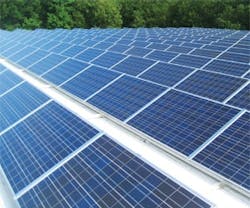A solar power purchase agreement (PPA) is one of the best ways to harvest renewable energy on site – no upfront expenditures, green energy, and discounted utility rates. It packs a financial one-two punch, giving you access to green energy without having to purchase a costly PV system.
Negotiating a PPA requires a firm understanding of the relationship you and your provider will share for 5-20 years. Maximize your contract by securing the right information.
Key Considerations
Roof: The number one consideration in a PPA is your roof’s viability in terms of age, layout, and type. Five to 10-year-old roofs with no major repairs in the next decade are excellent candidates, says Mike Silvestrini, president of Greenskies. Your roof also needs to be able to support the added weight of a PV array. "If the roof doesn’t have enough load-bearing capability, you’re not going to be able to put a solar system on there," says Jake Swenson, sustainability manager for Staples, which uses PPAs. Locate your site and roof plans to help your provider appraise your roof.
Load: If energy isn’t going into your facility, neither you nor the provider will benefit from an arrangement. To determine if a power load can be replaced with solar, a provider will need your energy bills to decipher your peak times and usage, says Silvestrini. It will also ensure you have a competitive solar rate for your area.
Financing: Providers evaluate your company’s financial history as well as the economic stability of your sector, so be on standby with financial records. "The most attractive accounts have very good long-standing credits and are very stable organizations," says Matthew Dickey, director of sales at SunEdison. He adds that low turnover properties and essential-use buildings also attract the eyes of financiers.
The Provider: Research your provider’s credentials with financial institutions, solar manufacturers, and utility companies. "Look at the financial stability and depth of the developer, their capabilities and cost efficiency in terms of their sourcing of product and installation," Swenson advises. They should have monitoring and maintenance capabilities, as well as ways to generate reports on the PV’s output.
Your Financial Perks
The ability to anticipate your energy costs over the years, instead of being subject to a fluctuating utility market, is a remarkable advantage. Your solar energy rates are fixed on a sliding scale, which is set for the duration of your contract. All you need to do is adjust to paying two energy bills a month.
"Hosts can plan around their energy spend for the next 20 years," says Dickey. "They know how much in year 18 they’re going to be paying for X percent of their power. That’s a valuable and beneficial position to be in."
Staples, with 95% of its buildings leased, has seen great success with PPAs. As of last year, they had over 25 active solar rooftops, each one producing 5-30% of the facility’s annual energy costs. "The long-term price certainty is important," says Swenson. "We’re seeing savings increase over time as the utility rates increase more than our escalation rates in the PPA."
A Host’s Responsibilities
An entire year may be devoted to finalizing your PPA – preparing the contract, securing financing and interconnection approval, and constructing the PV. Once it’s completed, your obligations entail providing access to the system for monitoring and maintenance and paying for the electricity the system produces. The rest is dependent on the sun.
Jennie Morton ([email protected]) is assistant editor for BUILDINGS.
About the Author
Jennie Morton
A former BUILDINGS editor, Jennie Morton is a freelance writer specializing in commercial architecture, IoT and proptech.
